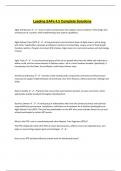Leading SAFe 4.5 Complete Solutions
Agile Architecture ✔️✔️A set of values and practices that support active evolution of the design and
architecture of a system, while implementing new system capabilities.
Agile Release Train (ART) ✔️✔️A long-lived and cross-functional team-of-Agile-teams, which along
with other stakeholders, develops and delivers solutions incrementally, using a series of fixed-length
Iterations within a Program Increment (PI) timebox. Aligns teams to a common business and technology
mission.
Agile Team ✔️✔️A cross-functional group of five to ten people who have the ability and authority to
define, build, and test some element of Solution value—all in a short Iteration timebox. Specifically, it
incorporates the DevTeam, Scrum Master, and Product Owner roles.
Architectural Runway ✔️✔️Consists of the existing code, components and technical infrastructure
necessary to support implementation of prioritized, near-term features, without excessive redesign and
delay.
Built-in Quality ✔️✔️Practices that ensure that each Solution element, at every increment, meets
appropriate quality standards throughout development.
Business Owners ✔️✔️A small group of stakeholders who have the primary business and technical
responsibility for governance, compliance, and Return on Investment for a Solution developed by an
Agile Release Train (ART). They are key stakeholders on the ART who must evaluate fitness for use and
actively participate in certain ART events.
What is the RTE’s role in coordinating with other Release Train Engineers (RTEs)?
The RTE collaborates with other RTEs to share best practices, address cross-train dependencies, and
align on overarching program goals and strategies. ✔️✔️
How can an RTE facilitate effective remote work for distributed teams?
,The RTE can implement tools for virtual collaboration, establish clear communication protocols, and
schedule regular check-ins to maintain team cohesion. ✔️✔️
What is the significance of fostering a culture of accountability within the ART?
A culture of accountability encourages team members to take ownership of their work, enhances trust
among team members, and improves overall performance and productivity. ✔️✔️
How does the RTE support the Product Owner in backlog management?
The RTE assists the Product Owner by facilitating backlog refinement sessions, ensuring alignment on
priorities, and helping to clarify requirements for the team. ✔️✔️
What techniques can an RTE use to enhance stakeholder participation in program events?
The RTE can actively invite stakeholders to participate, create engaging agendas, and ensure that
stakeholder input is valued and incorporated into discussions. ✔️✔️
How does the RTE ensure that teams conduct effective retrospectives?
The RTE encourages teams to focus on specific outcomes, provides facilitation support, and ensures that
action items are tracked and followed up on in subsequent sprints. ✔️✔️
What strategies can an RTE implement to support teams in achieving their PI objectives?
The RTE can help teams break down PI objectives into actionable tasks, monitor progress regularly, and
facilitate discussions to address challenges. ✔️✔️
How does the RTE help in identifying training needs within the ART?
The RTE can assess team capabilities, solicit feedback on skills gaps, and coordinate training sessions to
support team development and enhance performance. ✔️✔️
What is the importance of maintaining open communication channels within the ART?
Open communication channels foster transparency, enhance collaboration, and ensure that team
members can share updates, challenges, and ideas freely. ✔️✔️
, How can an RTE promote sustainability in team practices?
The RTE can advocate for sustainable work practices, encourage a balanced workload, and promote the
importance of team well-being for long-term productivity. ✔️✔️
What role does the RTE play in guiding teams through agile ceremonies?
The RTE ensures that teams understand the purpose of each ceremony, facilitates the ceremonies
effectively, and encourages participation to achieve desired outcomes. ✔️✔️
How can an RTE help improve the quality of deliverables?
The RTE can promote quality assurance practices, encourage regular testing, and facilitate discussions
on quality metrics and goals throughout the development process. ✔️✔️
What is the RTE’s role in fostering innovation within the ART?
The RTE encourages a culture of innovation by providing time for creative thinking, promoting idea-
sharing sessions, and supporting experimentation with new approaches. ✔️✔️
How does the RTE handle challenges related to team dynamics?
The RTE identifies issues affecting team dynamics, facilitates discussions to resolve conflicts, and
promotes a collaborative environment that values diversity. ✔️✔️
What strategies can an RTE employ to ensure that the ART adapts to market changes?
The RTE can encourage teams to be flexible, regularly revisit priorities based on market feedback, and
support rapid iterations to meet changing demands. ✔️✔️
How does the RTE support cross-functional skill development among team members?
The RTE encourages knowledge-sharing sessions, promotes job rotation opportunities, and facilitates
training programs to develop a broader skill set within teams. ✔️✔️
Capabilities ✔️✔️A higher-level solution behavior that typically spans multiple Agile Release Trains
(ARTs). They are sized and split into multiple features so that they can be implemented in a single PI.




